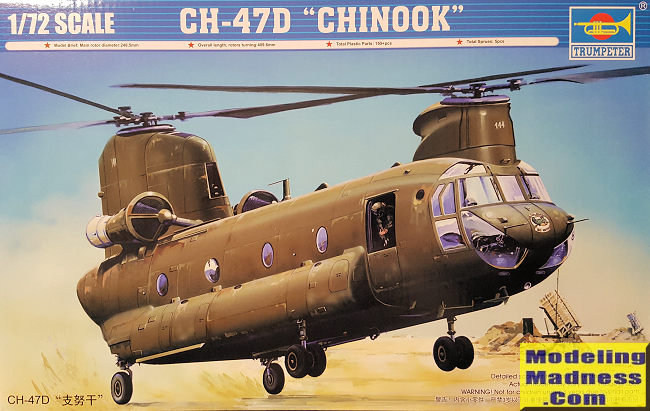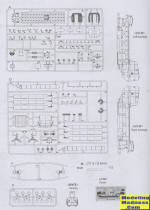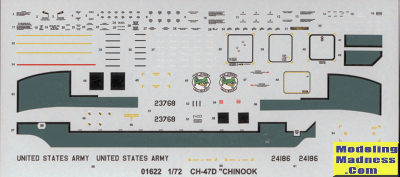
Trumpeter 1/72 CH-47D Chinook
| KIT #: | 01622 |
| PRICE: | $26.79 |
| DECALS: | Three options |
| REVIEWER: | Scott Van Aken |
| NOTES: | 2019 release |

| HISTORY |
The Boeing CH-47 Chinook is an American twin-engined, tandem rotor, heavy-lift helicopter developed by American rotorcraft company Vertol and manufactured by Boeing Vertol (later renamed Boeing Helicopter and now named Boeing Rotorcraft Systems). The CH-47 is among the heaviest lifting Western helicopters. Its name, Chinook, is from the Native American Chinook people of Washington state.
The Chinook was originally designed by Vertol, which had begun work in 1957 on a new tandem-rotor helicopter, designated as the Vertol Model 107 or V-107. Around the same time, the United States Department of the Army announced its intention to replace the piston engine-powered Sikorsky CH-37 Mojave with a new, gas turbine-powered helicopter. During June 1958, the U.S. Army ordered a small number of V-107s from Vertol under the YHC-1A designation; following testing, it came to be considered by some Army officials to be too heavy for the assault missions and too light for transport purposes. While the YHC-1A would be improved and adopted by the U.S. Marine Corps as the CH-46 Sea Knight, the Army sought a heavier transport helicopter, and ordered an enlarged derivative of the V-107 with the Vertol designation Model 114. Initially designated as the YCH-1B, on 21 September 1961, the preproduction rotorcraft performed its maiden flight. In 1962, the HC-1B was redesignated CH-47A under the 1962 United States Tri-Service aircraft designation system.
The Chinook possesses several means of loading various cargoes, including multiple doors across the fuselage, a wide loading ramp located at the rear of the fuselage and a total of three external ventral cargo hooks to carry underslung loads. Capable of a top speed of 170 knots (200 mph; 310 km/h), upon its introduction to service in 1962, the helicopter was considerably faster than contemporary 1960s utility helicopters and attack helicopters, and is still one of the fastest helicopters in the US inventory. Improved and more powerful versions of the Chinook have also been developed since its introduction; one of the most substantial variants to be produced was the CH-47D, which first entered service in 1982; improvements from the CH-47C standard included upgraded engines, composite rotor blades, a redesigned cockpit to reduce workload, improved and redundant electrical systems and avionics, and the adoption of an advanced flight control system. It remains one of the few aircraft to be developed during the early 1960s – along with the fixed-wing Lockheed C-130 Hercules cargo aircraft – that has remained in both production and frontline service for over 50 years.
| THE KIT |
 This
is not the first kit of the CH-47 in 1/72, but the only other one that comes to
mind is the offering by Matchbox. It wasn't a bad kit, which can be said about
most Matchbox kits, but it was lacking in detail, especially on the inside. This
one by Trumpeter was released in 2019, making it fairly recent. You are provided
a nice cockpit that includes both the collective and cyclic controls along with
foot pedals. A nice instrument panel with raised detailing is also included.
There is a full cabin floor along with a bulkhead that includes detail for the
radio equipment.
This
is not the first kit of the CH-47 in 1/72, but the only other one that comes to
mind is the offering by Matchbox. It wasn't a bad kit, which can be said about
most Matchbox kits, but it was lacking in detail, especially on the inside. This
one by Trumpeter was released in 2019, making it fairly recent. You are provided
a nice cockpit that includes both the collective and cyclic controls along with
foot pedals. A nice instrument panel with raised detailing is also included.
There is a full cabin floor along with a bulkhead that includes detail for the
radio equipment.
All of the cabin windows install from the inside so it is probably best to prepaint the fuselage halves in those areas and mask them when the entire airframe is done. There are no cabin seats or other fixtures. The base areas for the rotors need to be installed prior to closing the fuselage halves. There are two engines, both with the standard filters over the intakes. The main cabin door is separate, though not designed to be lowered.
On the underside, the landing gear and antennas, for which there are many, are installed. You can put a cover over the hook well or leave that off to show the cargo hook. One thing that is designed to be lowered is the rear cargo ramp. The last items are the installation of the cockpit clear bits and the build of the rotor heads. Blades are molded with droop in them.
 Instructions
are well done with Gunze paint references. There are three markings options, all
of them in overall olive drab. These helos are fairly boring when it comes to
markings with little more than titles and serial numbers. None of the units are
described. Fortunately, there are aftermarket decals out there if you want
something a bit different. Decals are nicely printed.
Instructions
are well done with Gunze paint references. There are three markings options, all
of them in overall olive drab. These helos are fairly boring when it comes to
markings with little more than titles and serial numbers. None of the units are
described. Fortunately, there are aftermarket decals out there if you want
something a bit different. Decals are nicely printed.
| CONCLUSIONS |
If you are going to tackle this aircraft in 1/72, then this one should be the one to use. It will make into a fairly large model in this scale, but is one that no dedicated helo collection should be without.
| REFERENCES |
https://en.wikipedia.org/wiki/Boeing_CH-47_Chinook
August 2021
Copyright ModelingMadness.com. All rights reserved. No reproduction in part or in whole without express permission.
If you would like your product reviewed fairly and fairly quickly, please contact the editor or see other details in the Note to Contributors.